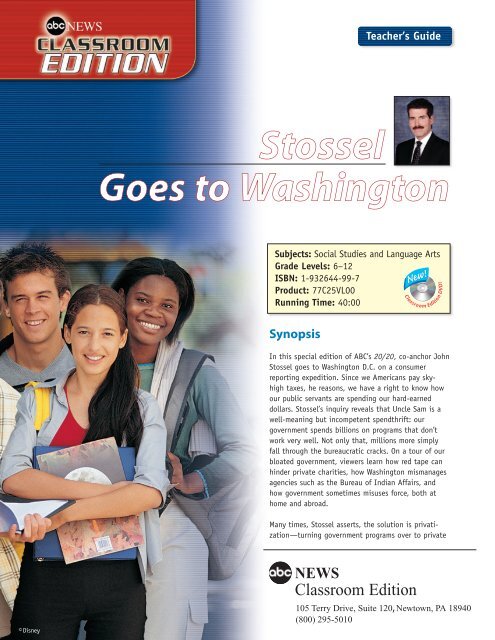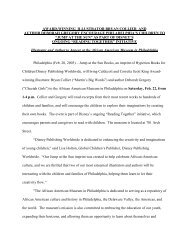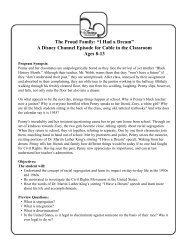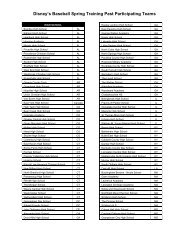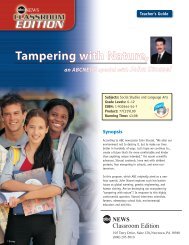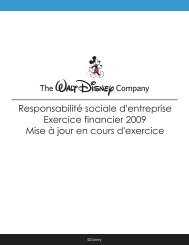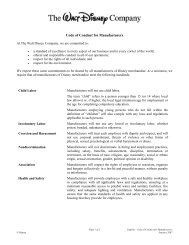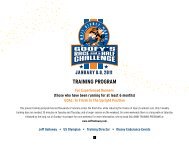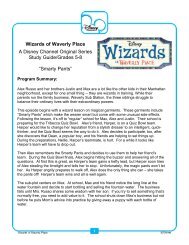Stossel Goes To Washington
Stossel Goes To Washington
Stossel Goes To Washington
You also want an ePaper? Increase the reach of your titles
YUMPU automatically turns print PDFs into web optimized ePapers that Google loves.
Teacher’s Guide<strong>Stossel</strong><strong>Goes</strong> to <strong>Washington</strong>Subjects: Social Studies and Language ArtsGrade Levels: 6–12ISBN: 1-932644-99-7Product: 77C25VL00Running Time: 40:00Editio n DV D!Classro o mSynopsisIn this special edition of ABC’s 20/20, co-anchor John<strong>Stossel</strong> goes to <strong>Washington</strong> D.C. on a consumerreporting expedition. Since we Americans pay skyhightaxes, he reasons, we have a right to know howour public servants are spending our hard-earneddollars. <strong>Stossel</strong>’s inquiry reveals that Uncle Sam is awell-meaning but incompetent spendthrift: ourgovernment spends billions on programs that don’twork very well. Not only that, millions more simplyfall through the bureaucratic cracks. On a tour of ourbloated government, viewers learn how red tape canhinder private charities, how <strong>Washington</strong> mismanagesagencies such as the Bureau of Indian Affairs, andhow government sometimes misuses force, both athome and abroad.Many times, <strong>Stossel</strong> asserts, the solution is privatization—turninggovernment programs over to private©DisneyNEWSClassroom Edition105 Terry Drive, Suite 120, Newtown, PA 18940(800) 295-5010
companies. <strong>To</strong> back up this argument, the reportercites numerous examples. Viewers learn aboutCanada’s privately-run air traffic control system,visit a privatized, well-run apartment complex forlow-income families, and hear patients andemployees praise a for-profit ambulance companythat features speedy service and state-of-the-artequipment.The DVD contains the following chapters. You mightuse this program as part of a social studies or languagearts unit focussing on critical thinking, drawingconclusions, and identifying facts and opinions.Chapter 1: IntroductionJohn <strong>Stossel</strong> points out that our federalgovernment finances and directs a myriadof programs—everything from garbagecollection to opera performances onpublic TV. <strong>To</strong> bankroll such programs,<strong>Stossel</strong> claims, the average taxpayer chipsin about a third of his or her income. Thisis not what the founding fathers had inmind, says Professor Tibor Machan ofChapman University, whom <strong>Stossel</strong> interviewsthroughout the program.Government, Machan insists, shouldprotect our civil rights and defend us againstforeign aggression—and that’s all!Chapter 2: The Department of the InteriorFirst stop on <strong>Stossel</strong>’s muckraking tour is TheDepartment of the Interior. Instead of protectingwilderness lands under the Department’s supervision,says <strong>Stossel</strong>, government workers accidentallystart huge forest fires, burning people’s homesin the process. Another Interior Department agency,the Bureau of Indian Affairs, is supposed to takecare of Native Americans living on reservations. Forthe Lakota Sioux, however, alcoholism is commonand the average life expectancy has dropped to thatof a Third World nation. Many blame this decline onthe BIA’s incompetence. In contrast, the Choctawpeople of Mississippi manage their own affairs—andhave a thriving business community to show for it.Chapter 3: The Department of Housing andUrban DevelopmentHUD, <strong>Stossel</strong> points out, spends billions on publichousing, only to let complexes fall into suchdisrepair that it’s necessary to demolish them andstart over. In this segment, <strong>Stossel</strong> shows howprivatization transformed an unsafe, dilapidatedpublic housing project into a decent, wellmaintainedcommunity for low-income families.Chapter 4: Privatizing Public Services<strong>Stossel</strong> sets out to show that even when it comesto essential services that government usuallyprovides, private businesses do a better job at alower cost. <strong>To</strong> prove his point, the 20/20 co-anchorcites examples such as a privatized water system inJersey City, New Jersey, a pay-as-yougohighway in California, and Canada’ssuccessful privately-run air trafficcontrol system.Chapter 5: When GovernmentStands in Charity’s Way<strong>Stossel</strong> visits Delancey Street, a SanFrancisco mutual-aid network thatrehabilitates ex-felons and addictsthrough job training in its own businesses. Aprivate foundation, Delancey Street is still plaguedwith government red tape. <strong>Stossel</strong> and othersbelieve that when charities do a good job,government should simply get out of the way.Chapter 6: When Government UsesForce/Summing UpIn this segment, <strong>Stossel</strong> illustrates government’smisuse of force. For example, in New Rochelle, NewYork, in order to make room for a huge Ikeafurniture store, the mayor wanted to level a longestablishedneighborhood. Ikea cancelled theproject, but residents could easily have lost theirhomes, thanks to eminent domain, thegovernment’s power to acquire private propertywhether owners like it or not. <strong>Stossel</strong> also deploresseveral examples of government intervention~2~©Disney
abroad. Instead of keeping the peace or haltingterrorism, he says, we often end up creating newenemies.ObjectivesThe student will:Finally, Professor Tibor Machan sums up theprogram, warning against rising taxes andgovernment bloat. John <strong>Stossel</strong> predicts that thistrend won’t change.■■Learn about civics topics such as taxation,United States government agencies andprograms, and eminent domain;Explore ethical, philosophical, sociological, andeconomic issues such as responsibilities andpowers that the U.S. government shouldreasonably possess;■Analyze perspectives about various aspects ofUnited States history, and draw upon historicalknowledge during the examination of socialissues;■Integrate individual stories about people,events, and situations to form a more holisticconception, in which continuity and change arelinked in time and across cultures.Background InformationJohn <strong>Stossel</strong>Born in 1947, John <strong>Stossel</strong> is a 1969 graduate ofPrinceton University, where he earned a BA inpsychology. He started his journalism career as aresearcher for a Portland, Oregon, television station.When ABC TV first hired him, <strong>Stossel</strong> became theconsumer editor on Good Morning America. He joinedABC’s newsmagazine show, 20/20, in 1981 and roseto the role of co-anchor (with Barbara Walters) in2003. <strong>Stossel</strong> began hosting his own one-hourspecials in 1994. On these and on his 20/20 opinionsegment called Give Me a Break, he deals skepticallywith topics ranging from pop culture to politics tocensorship to widely believed but unfounded fears.<strong>Stossel</strong> has received many honors for his work,including 19 Emmy Awards.~3~©Disney
Preview QuestionsAsk these questions prior to viewingChapter 1: Introduction.1. Can you name some services that our local,state, and federal governments provide? Wheredo governments get the money for programslike these?2. In the United States, what percent of his orher earnings does an average adult pay intaxes? Do students like you pay taxes? Whatkinds?3. What is a government lobbyist?Ask these questions prior to viewingChapter 2: The Department of the Interior.4. Have you ever heard of the U.S. Department ofthe Interior? What do you think thisdepartment does?5. Are there any Indian reservations near yourcommunity? Why do some Native Americans liveon reservations? Who makes public decisions onreservations?6. What is public assistance? Do you thinkreceiving public assistance helps or harms poorpeople? Explain your answer.Ask these questions prior to viewingChapter 3: The Department of Housing andUrban Development.7. Have you ever heard of HUD, the U.S.Department of Housing and UrbanDevelopment? What kinds of responsibilities doyou think this department has?8. What is “low-income housing”? Who pays forit? Describe some low-income housing projectsthat you have seen. In these complexes who isresponsible for making repairs?9. Do you know what privatization means? Do youthink privately owned companies usually do abetter job than government programs? Explainyour answer.Ask these questions prior to viewingChapter 4: Privatizing Public Services.10. What are some essential public services thatgovernments provide? Do you think our federal,state, and local governments do a good, mediocre,or bad job of running electrical and watersystems, ambulance services, and other suchprograms? Give examples to support your answer.11. Why might people want their government,rather than private companies, to run safetyrelatedservices such as air traffic control?Ask these questions prior to viewingChapter 5: When Government Stands inCharity’s Way.12. What is “the poverty line”?13. What is a charity? How is a private charitydifferent from a government program such asWelfare? Why might government programs havemore rules and regulations than privatelyowned charities have?Ask these questions prior to viewingChapter 6: When Government UsesForce/Summing Up.14. Under what circumstances can our governmentuse force? Can you describe any cases in whichour government has used force with mostlynegative results?15. If government officials decided to build a roadthrough your neighborhood, would it be lawfulfor them to tear down your home in order tomake room? How about if they wanted to builda business such as a shopping center? Couldthey lawfully tear down your home to makeroom for that? Why or why not?~4~©Disney
16. If our president wants to bomb anothercountry, does he have to ask citizens’permission? Must he get an OK from Congress?Explain why you think this.Postviewing QuestionsAsk these questions after viewing Chapter 1:Introduction1. According to the tax expert whom John <strong>Stossel</strong>interviews, for how many months per year doesthe average married couple have to work inorder to pay their taxes? In addition to federalincome taxes, what other kinds of taxes domost Americans pay?2. What kinds of services do our local, state, andfederal governments provide? What servicesdoes Tibor Machan (the professor whom <strong>Stossel</strong>interviews) think our government shouldprovide? Why do you think he believes in sucha limited government?Ask these questions after viewing Chapter 2:The Department of the Interior.3. What examples does John <strong>Stossel</strong> provide tosupport his theory that the U.S. InteriorDepartment is incompetent?4. How do the Choctaw people’s lives differ fromthose of the Lakota Sioux? What accounts forthe difference, according to <strong>Stossel</strong> and thepeople he interviews?5. Why didn’t Interior Secretary Bruce Babbittwant John <strong>Stossel</strong> to interview him for thisprogram?6. Do you agree with the points that John <strong>Stossel</strong>makes during this part of the DVD? Does heprovide enough evidence to convince you?Explain your answer.Ask these questions after viewing Chapter 3:The Department of Housing and UrbanDevelopment.7. Why does the DVD show a group of high-risebuildings exploding? Who blew them up, and why?8. According to the information you learned fromthis program (and/or information that youalready knew), why do government-run housingprojects fall into disrepair?9. According to <strong>Stossel</strong> and those he interviews,why do private businesses do a better job ofrunning low-income housing developments thanthe federal government does? Does <strong>Stossel</strong>explain who pays private companies to runpublic housing projects?Ask these questions after viewing Chapter 4:Privatizing Public Services.10. What is John <strong>Stossel</strong>’s main point in thissegment of the DVD?11. What does the term privatization mean? Whatkinds of privatized services does <strong>Stossel</strong> showduring this segment? In what ways haveprivate businesses improved public services?12. Why do you think people might be wary of privatizingpublic services that protect people’s safety?13. Now that you have learned about Canada’sprivately owned air traffic control system,would you be in favor of privatizing air trafficcontrol in the United States? Why or why not?14. Is your community’s ambulance service run bythe government or a private company? Howabout your community’s water, gas, andelectrical systems? Do you think privatecompanies do a better job of running suchservices than government agencies do? Explainwhy you think so.~5~©Disney
Ask these questions after viewing Chapter 5:When Government Stands in Charity’s Way.15. What is Delancey Street? Is it a governmentprogram or a privately owned one? How doDelancey Street’s workers help one another?What does the term “mutual aid society” mean?16. What is the main point that John <strong>Stossel</strong>makes regarding private charities? Do you thinkgovernments should be able to regulate privatecharities? How about charities that receivegovernment money? Give reasons for youropinions.Ask these questions after viewing Chapter 6:When Government Uses Force/Summing Up.17. What does the term “eminent domain” mean?Do you think the government of New Rochelle,New York, had a right to tear down people’shouses to make room for an Ikea store? Why orwhy not? If you were one of the residentswhose home was threatened, what would yousay to the mayor?18. Under what circumstances do you think ourgovernment should use force against peopleoutside our borders?19. Now that you have seen the whole program,what do you think John <strong>Stossel</strong>’s and TiborMachan’s main points are concerning taxes,government programs, and private businesses?In general, do you agree or disagree with<strong>Stossel</strong> and Machan? Give reasons for youropinions.Suggested Activities1. Prior to viewing John <strong>Stossel</strong> <strong>Goes</strong> to<strong>Washington</strong>, distribute copies of the ResponseChart at the end of this Guide. Have studentsfill in the chart as they watch the DVD. Theninvite them to share and discuss their opinions,feelings, and questions about the issues thatJohn <strong>Stossel</strong> raises. Help students distinguishverifiable facts from opinions. If some studentsdisagree with conclusions that the 20/20reporter draws, encourage them to explain why.Ask them to do library and Internet research toback up their views.2. Read aloud the following statements from theDVD, one by one. Ask students to tell whomakes the statement, and what the speakermeans by it.• “Americans pay more in taxes than we do infood, clothing, and shelter combined.”• “Some idiot lit a fire when the wind wasblowing. I think it’s a criminal act.”• “There’s no Bureau of Jewish Affairs. There’s noBureau of Irish Affairs.”• “I’m gonna fire whoever scheduled thisinterview.”• “The system is way cool. You have state-of-theartbrand-new ambulances. You have state-ofthe-artbrand-new equipment.”• “They want to put us out of our homes andbusinesses and destroy two churches, so theycan come in and sell furniture?”• “I have to move my city forward and renewareas that have fallen into disrepair and intoblighted conditions.”~6~©Disney
3. Have students design and conduct surveys tofind out whether most people believe that: 1)Americans pay too much money in taxes; 2)Our government is too big; and 3) Mostgovernment programs are ineffective. Guidestudents to write survey questions that soundneutral rather than biased. Tell them toattempt to interview a variety of people (basedon traits such as age, income level, culturalgroup, and political affiliation). Before theyconduct their surveys, students should writehypotheses that predict what their research willreveal. Have students write short essays to sumup the data that they collect.4. Students may enjoy watching and reviewing the1939 Frank Capra film Mr. Smith <strong>Goes</strong> to<strong>Washington</strong>, starring Jimmy Stewart. (They canborrow the movie from a public library or rentit from a video/DVD store.) As students writetheir reviews, ask them to consider the film’splot, dialogue, casting (choice of actors to playvarious roles), music, editing (how thedifferent scenes are pieced together), andmessages, as well as actors’ performances.Reviewers may also want to compare the film’smain theme to that of John <strong>Stossel</strong> <strong>Goes</strong> to<strong>Washington</strong>. Collect their reviews in a bookletso that classmates can compare their opinions.5. Have students search the Internet for recentarticles, press releases, and editorials on “biggovernment,” “government bloat,” “pork barrellegislation,” and “deficit spending.” They canprint out the articles and scan them forportions that link Republicans and/orDemocrats to expanding government programs.After students read the articles, lead adiscussion on the following question: Do moreDemocrats than Republicans vote to expand thefederal budget, or do the two major partiesseem equally responsible for “governmentbloat”?Activities to accompany Chapter 1:Introduction.6. Have students interview local officials or doInternet research to find out what kinds oflocal taxes people pay in your community.These might include sales taxes, taxes onbusinesses, luxury or “sin” taxes, gas taxes,and taxes that help pay for local schools. Eachstudent can report back to the group on adifferent kind of tax. After each report,students can vote on whether or not the taxseems fair and reasonable.7. Have students research the history of federalincome taxes in the United States and create atimeline and bar graph showing their findings.Internet sources on this topic include:• “Taxing Times,” a transcript from OnlineNewsHour on PBS:• History of the Income Tax in the United Statesfrom infoplease.com:• History of the Tax System in the United Statesfrom worldhistory.com:• IRS History and Structure from the InternalRevenue Service’s website:8. If any students have part-time jobs, invitethem to use their paycheck stubs to calculatethe percentage of earnings that is deductedfrom their paycheck each pay period. Havestudents do library and Internet research tocreate a glossary on tax terms. Ask them todefine terms such as the following:~7~©Disney
tax brackettax returntax sheltertax refundtax deductionSocial Security numberThey might use the following books asresources:• Paying Taxes by Sarah De Capua (Children’sPress, 2002)• Taxes by Norman L. Macht (Chelsea House,2001)• Taxes for Dummies 2004 by Eric Tyson andDavid J. Silverman (John Wiley & Sons, 2003)Activities to accompany Chapter 2: TheDepartment of the Interior.9. Have students visit the Interior Department’swebsite and read some of the department’scurrent news releases at. Then theymight pick one topic to research on the Internetsearch. Tell them to find out how newspapers’and environmental or conservation groups’versions of the news story differ from that of theInterior Department. Ask students to write essaysthat contrast different sources’ versions. Ifstudents have difficulty locating news articles,tell them that some search engines, such asgoogle.com, have news search functions.10. Some Native American groups, including theChoctaw people of Mississippi, have establishedlegal gambling casinos and used these as amethod of fighting poverty in their communities.Yet many people oppose gambling onmoral, religious, or other grounds. For example,some people believe that gambling establishmentsencourage crime. Have teams of studentsresearch this topic and hold a debate on thisquestion: Is legal Indian gaming more beneficialthan it is harmful, or vice versa? One Internetsource might be the following (created by a UCBerkeley researcher):.11. Have pairs or individual students each choose aNative American group to research. They shouldfind out where the group’s reservation(s) arelocated, where the people originally lived, howthey lived before European soldiers and settlersarrived, how Europeans affected their history,who their heroes were and are, what the tribe’seconomic state is today, and what its futureprospects are. Researchers can share theirfindings by creating bulletin board displays.Native American tribes include the following:Apache Comanche Miami Nez Perce PotowatomiArapahoe Havasupai Mission Omaha PuebloCayuga Hopi Miwok Oneida PuyallupCherokee Kickapoo Modoc Osage SeminoleCheyenne Klamath Mono Paiute ShawneeChippewa Lakota Sioux Narrangansett Pawnee ShoshoneChoctaw Menominee Navajo Pomo Zuni~8~©Disney
Activities to accompany Chapter 3: TheDepartment of Housing and UrbanDevelopment.12. If possible, invite a local HUD representative toclass. Students might show the governmentemployee this portion of the DVD and ask himor her to comment. Encourage students to askquestions such as the following:• Why do you think so many government-subsidizedhousing developments have fallen intodisrepair? Who is responsible?• What are some drawbacks to privatizing lowincomehousing?• When low-income housing is run by privatebusinesses, how are the owners compensated?(Does HUD pay them?)13. Ask students to imagine that they have bought alarge, run-down housing complex in a city center.Tell them to suppose that they have enoughmoney to renovate the complex. Have studentsbrainstorm a list of aesthetic elements andservices that could transform this cluster of dilapidatedapartment buildings into a community thatmakes residents feel welcome, safe, and neighborlytoward each other, instilling communityspirit. They can write a detailed description oftheir renovated housing development and/or drawa “blueprint” of it. Remind students to redesignthe outdoor spaces as well as the indoor ones.Activities to accompany Chapter 4:Privatizing Public Services.14. Have students imagine that a private companytook over an aspect of your school such asrunning the cafeteria or teaching the art andmusic classes. Ask students to think aboutimprovements and problems that this might cause,and write an essay about the pros and cons.Remind them to consider issues such as reactionsfrom parents and workers’ unions, as well asprivate companies’ need to make a profit.15. Ask a government workers’ union representativeto speak to your class concerning his or herunion’s position on privatization. Studentsmight ask questions such as the following:• Is your union opposed to privatization? If so,please explain why.• In our community, are private companies thattake over public services obligated to hireunion workers who used to work for thegovernment?• What are some benefits that workers get frombelonging to a union such as yours?When a unionized business hires a new worker,is that worker obligated to join the union?Please explain how this works.• What happens when union workers go onstrike? What are some reasons for strikes?Activities to accompany Chapter 5: WhenGovernment Stands in Charity’s Way.16. Have students call local charities and ask tospeak with directors concerning the pros andcons of government regulations. They might askquestions such as the following:• Who or what funds your charity? Do you getany money from local, state, or federalgovernment grants?• What are some of the government regulationsthat your charity must follow?• Do know of any instances in which governmentregulations helped charities to do their work orprotected workers or clients from harm? Pleasetell what happened.• What could the government do to help yourcharity function even better?• Do you agree with the following statement?“When something good is happening [at a~9~©Disney
charity, government should just], step out ofthe way.” Please explain why you agree ordisagree.17. Have students research volunteer work thatthey might be able to do in your community.Encourage them to find a charity or othervolunteer program that interests them and willgive them an opportunity to learn somethingnew. If some students are already working asvolunteers, have them give short oral presentationstelling what they do, whom they help,and how they feel about their work. Informstudents that some college admissions departmentslook for applicants with volunteerexperience as well as high grades and testscores. Volunteering is also a way to make newfriends and broaden one’s perspective.Activities to accompany Chapter 6: WhenGovernment Uses Force/Summing Up.18. New Rochelle’s mayor tells John <strong>Stossel</strong> that hewants to “move [his] city forward and renewareas that have fallen into disrepair and intoblighted conditions.” Have students writepolite letters to the mayor of New Rochelleexplaining their opinions of his plan to teardown a neighborhood in order to make roomfor an IKEA furniture store.19. Encourage students to hold a discussion on thefollowing questions, after doing relevantresearch: Would John <strong>Stossel</strong> and Professor TiborMachan consider the war in Iraq an appropriateuse of force? Do you think this war was justified?Compare the Iraq war that began in 2003 to thewar in Afghanistan that followed the 9/11/2001terrorist attacks and to the Gulf War, which theU.S. fought in 1991 under the first PresidentBush. What do you think <strong>Stossel</strong> and Machanwould say about each? Could any of theseconflicts be called “protecting our borders”?Internet ResourcesIf you have access to the Internet, here are somesources of information on issues that John <strong>Stossel</strong>discusses on the DVD:The Delancey Street FoundationDelancey Street is the successful mutual-aid societythat John <strong>Stossel</strong> visits. Its website provides detailsabout Delancey Street’s clients and businesses.Habitat for HumanityLike Delancey Street, Habitat for Humanity is amutual-aid society. Its mission statement explainsthat “through volunteer labor and donations ofmoney and materials, Habitat builds and rehabilitatessimple, decent houses with the help of thehomeowner (partner) families. Habitat houses aresold to partner families at no profit, financed withaffordable, no-interest loans. The homeowners’monthly mortgage payments are used to build stillmore Habitat houses.” Major supporters of theprogram, Former President Jimmy Carter and his wifeRosalynn actively participate in Habitat projects.< http://www.habitat.org>The Department of Housing and UrbanDevelopmentHUD’s website presents detailed information on theDepartment’s various housing programs.< http://hud.gov/>The Interior DepartmentThe DOI’s website presents historical informationand current news releases on the Department’svarious programs and agencies, including theBureau of Indian Affairs.~10~©Disney
Activity #1: Response ChartAs you watch John <strong>Stossel</strong> <strong>Goes</strong> to <strong>Washington</strong>, use the second column of the chart to record yourreactions to the information John <strong>Stossel</strong> reports, as well as the opinions and conclusions that he andothers express. Also jot down any questions that come into your mind as you view the show.<strong>To</strong>pic ThatJohn <strong>Stossel</strong> DiscussesYour Own Opinions, Feelings, and QuestionsAn average American’stax burdenThe U.S. Departmentof the InteriorThe Bureau ofIndian AffairsHousing for low incomefamilies—government-run andprivately-run projectsPrivatization of public servicessuch as water systems,highways, air traffic control,and ambulance servicesGovernment regulation ofprivate charities and“mutual aid societies”“Eminent domain”—government’s ability to takeover private landGovernment’s use of forcein other countries~11~©Disney


